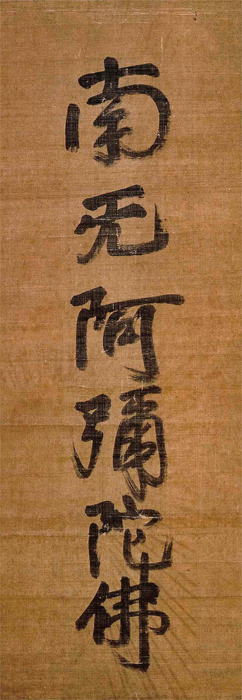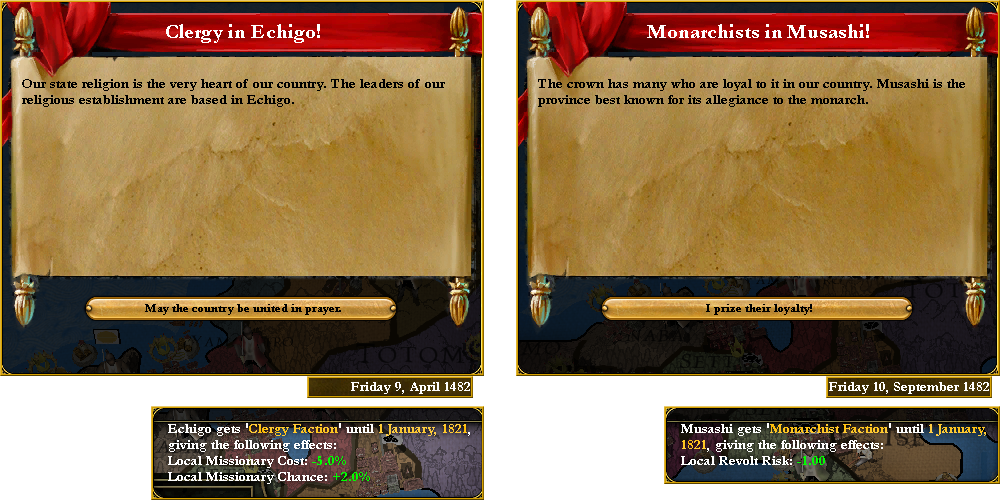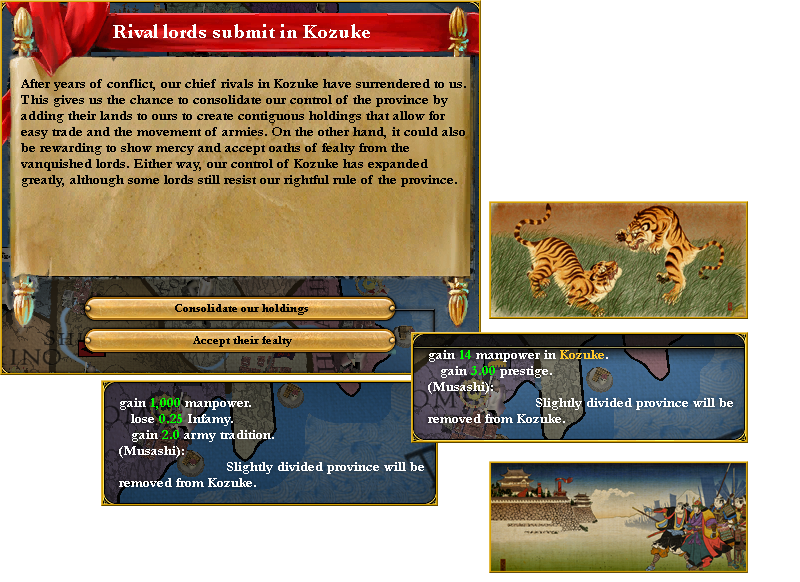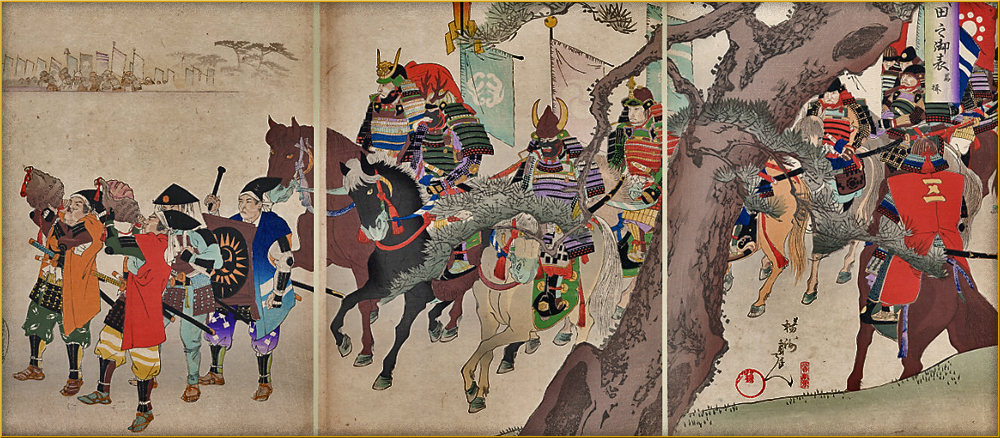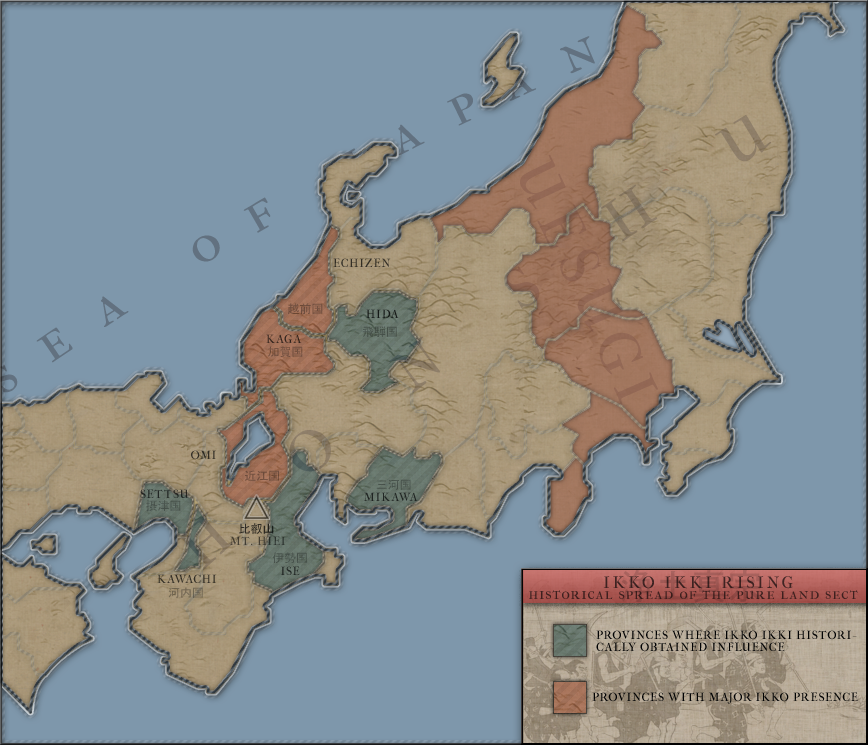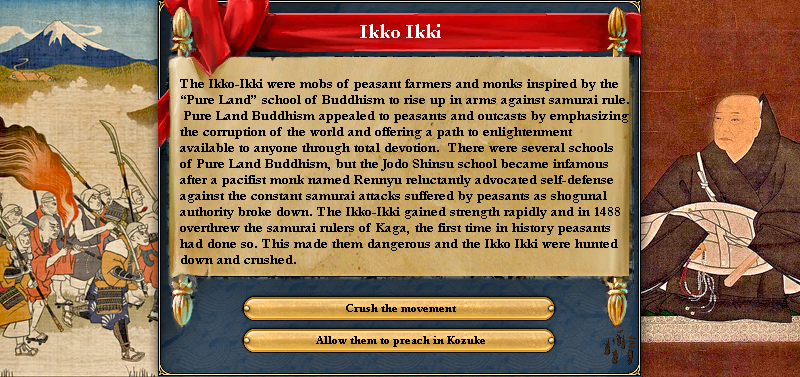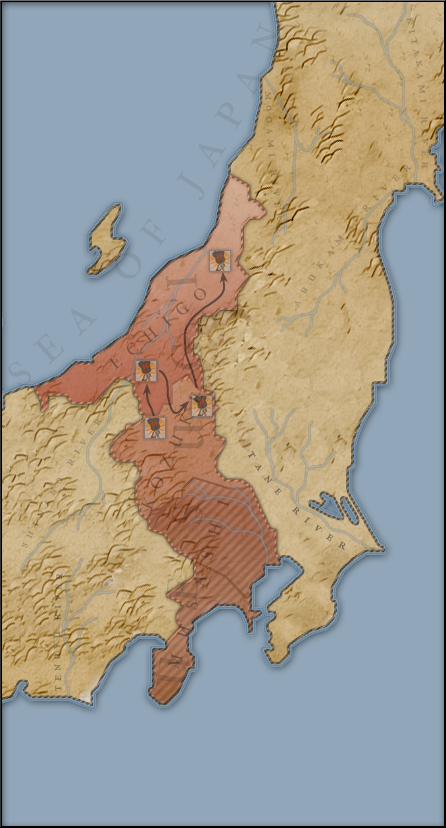Chapter 2
– The Feud on the Mountains of Jomo -
***
- Gameplay notes -
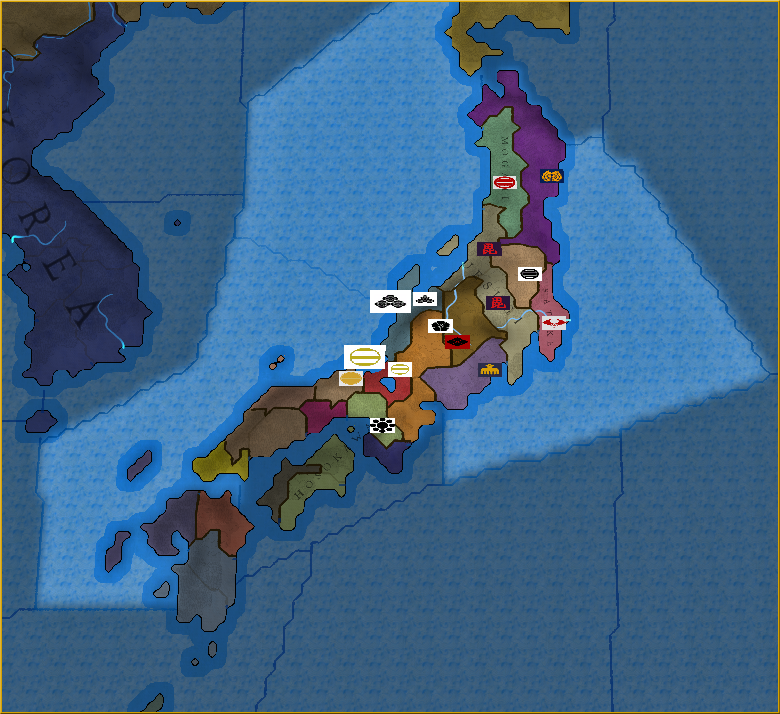
– The Feud on the Mountains of Jomo -
***
- Gameplay notes -

Historically Japan was divided into roughly 70 provinces which again were subdivided into prefectures, fiefs and other micro-governmental entities reaching almost legion in numbers. Magna Mundi has for a variety of reasons reduced this number to 28 (excluding Hokkaido). Thus the Uesugi’s ingame Musashi province is a conglomerate of three historically adjacent provinces (who, however, do not belong to the same historical region), namely the already mentioned Musashi province along those of Izu and Sagama.
This setup obviously downplays the diverse and widely contested conflict that was the Sengoku Jidai, where the country was torn asunder on almost all levels of society.
As a compensation for this Magna Mundi operates with a four-tier modifier system that describes the level of central clan authority over the provinces in question.
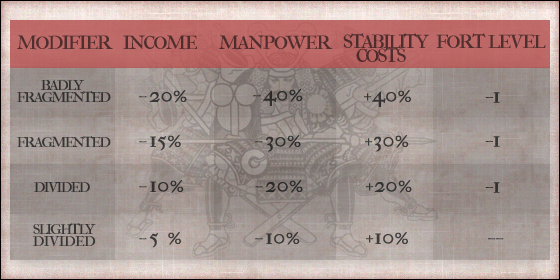
Provinces are usually far more divided than the map suggests.
In order to solidify a player’s hegemony over his province(s) and unite the patchwork of fiefs that make up the clan’s domains, the player can launch different kinds of campaigns against the obstinate lesser fractions within the province in question either by fulfilling certain conditions and trigger the event “Feuding Daimyo” through the provincial decision window or waiting for the event to appear randomly (which can be accelerated by posting large armies within a province, provoking your adversaries to face the clan). Launching a campaign manually gives you the ability to prepare enough men and provisions, but increases the strength of the rebels spawned to represent forces hostile to your clan, whereas engaging in an inter-provincial feud reduces the strength of the enemy in lieu of your clan chancing upon a golden opportunity to enforce its control.
If you, for whatever reason, decide to launch a campaign you’ll be given the choice in the event whether to engage in a provincial or concerted campaign which will grant specific modifiers to the province in question. The first type of campaign conveys a set of negative modifiers upon the province (such as revolt risk – spawning “disloyal Uesugi vassals”) over a longer period of time whilst the latter is both shorter in terms of time to pass before the province is pacified, but also severely increases the negative modifiers of the provincial campaign.

Should the fortunes of war be against you and the rebellious enemies succeed in sieging the province for even a short amount of time, the campaign might just end in failure – thus de facto reducing the control your clan holds over the disputed fiefs.
Considering the wider effects of, for example, engaging in a concerted campaign you’ll lose both stability and manpower whilst also increasing war exhaustion and infamy. Of these modifiers, the loss of manpower might just be the worst. The Japanese clans are small, thus rendering stability regeneration rather straightforward, but the loss in manpower may be crippling for your overall strategic goals if you should suddenly find yourself at war with your neighbours or, God forbid, the bakufu whilst conducting a campaign in one of your provinces.
*
-The Feud on the Mountains of Jomo -
***
-The Feud on the Mountains of Jomo -
***
By August 6th 1480, Uesugi Akisada had mustered such a large force within Kozuke that he felt himself strong enough to commence offensive operations against those retainers who had omitted to deliver taxes or taken too great a liberty in running their own affairs.
Consisting of numerous loyal vassals and retainers, Akisada’s army mobilized in the midst of August with Sojun Tsutsui leading the van whilst Naoie Date took the rear, commanding the incredible vital flow of supplies[1]. The shugo himself took charge of the middle of the column that snaked its way across the hills of Kozuke, spiked with banners.
However, the campaign preparations had not exactly been conducted in secret and as such the retainers who were to be on the receiving end of Akisada’s onslaught had amble time to prepare themselves. Behind a screen of make-shift fortresses on the mountain ridge called Jomo, the rebellious league raised an army of some 5,000 drafted ashigaru[2] and a shock force of some thousand mounted samurai retainers.
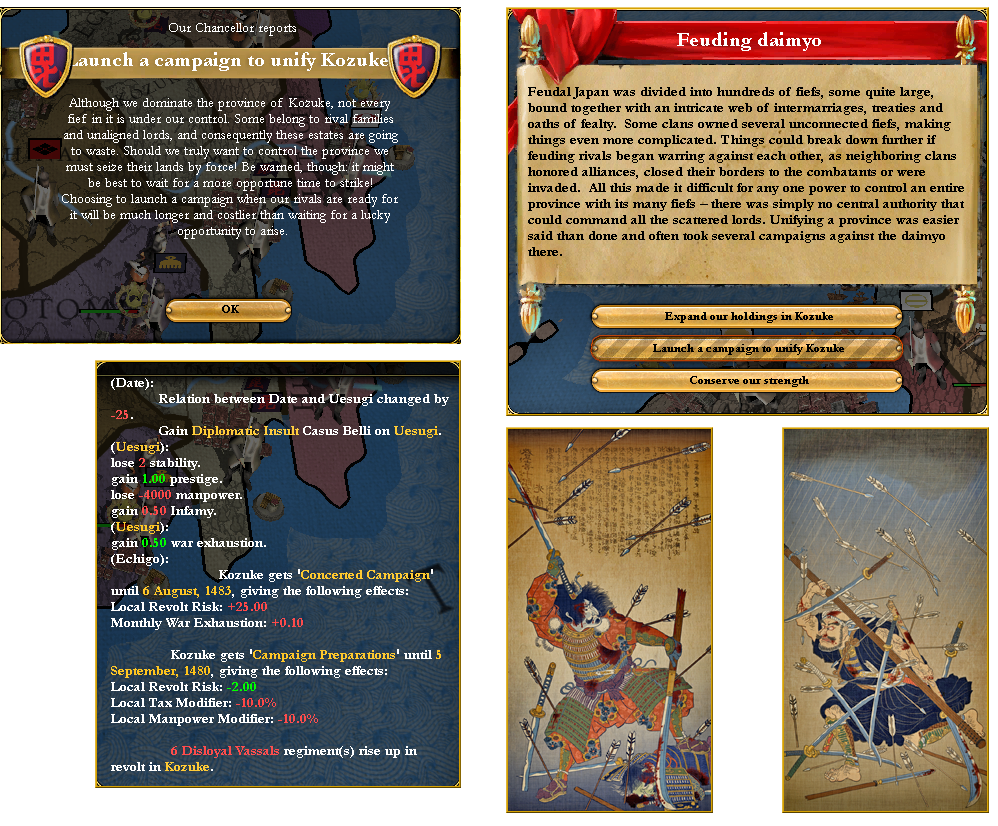
Facing the rebels were a 7000 man strong army under the command of Akisada. The force was subdivided into three columns of 2,000 mixed ashigaru formations with the advancing infantry being screened by a mounted force of 1,000 professional samurai and loyal retainers of the Uesugi.
The Uesugi troops struck camp on a bend in the Tonegawa River, facing the amassing rebels in the hills who shovelled arrows and insults alike down upon the advancing loyalist forces.
At the end of the month Akisada saw that the enemy was unlikely to abandon their fortified positions, and subsequently convened his commanders in the centre of his camp and instructed them to feign a withdrawal in separate columns, hopefully luring the rebels off the high ground and right into the awaiting arms of the loyal retainers.
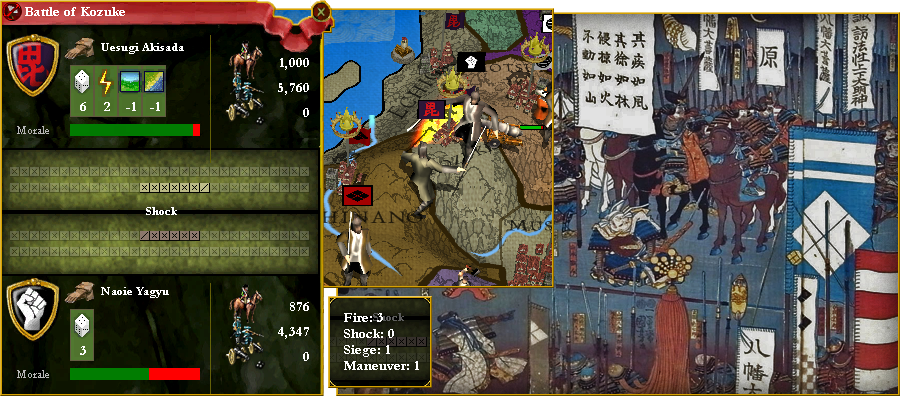
The ikki[3] troops were led by the famed Kinai swordsman, Naoie Yagyu who had assumed command on guarantee of great wealth and ransom from the defeated Uesugi family, however, his skill with the katana exceeded that of his wit with a commander’s baton.
Taking the retreat of his enemy as a sign of cowardice, Yagyu hoisted the mon of his family by the banners of the uprising and ordered his men forward, crossing the river bend by bridges and shallow water. Drenched by the surge and exhausted from their rapid advance, the insurgent forces streamed into the open land, gasping for breath and victory.
However, Akisada’s fresh troops halted. Then turned. And attacked.
Smashing through Yagyu’s fatigued and disorganized formations, the pikes and arrows of the Uesugi ashigaru pulverized any form of cohesion amongst the rebels whilst the mounted samurai swept around the river bend, cutting off any route of escape.
Struck with disbelief, the ikki commander could only watch as his infantry, trapped, surrendered or were slaughtered in the bottleneck created by the Uesugi battle plan. Bitter and disappointed, Naoie Yagyu composed his death poem before committing seppuko – ritual suicide. His cavalry scattered from the hills in the face of the victorious and hardly hurt loyalist troops.

Retaining the field was an unscathed Uesugi army that had just obliterated an opposing enemy almost equal in size. As a result, the battle on the Tonegawa River sent shock-waves through Kozuke’s districts, prompting several wavering rebels to seek mercy and amnesty at the loyalist banner.
As September came around and the campaigning season limbered to its approaching end, the rebellion had for all intents and purposes been stomped out. However, several members of the league such as the Washizu and Miki shugodai holed up in their fortresses and emptied their villages in preparation for coming sieges.
Akisada decided to detach some contingents from Tsutsui’s column and detailed them to envelop the resisting fortifications and starve the enemy into submission.
One by one the castles succumbed to hunger or were taken by either storm or treachery; leaving Kozuke province more or less united behind the Uesugi clan just little more than a year after the first large pitched battle had been fought.
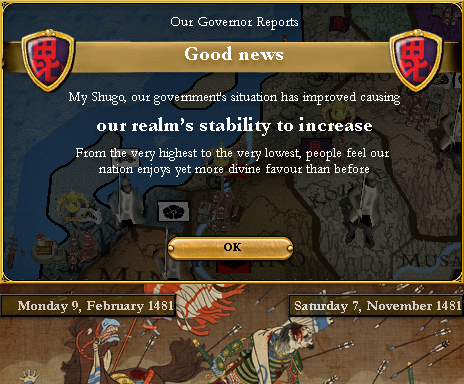
However, the Uesugi family was not entitled to a long rest in the wake of this successful domestic campaign. Trouble was brewing once again in Muromachi.
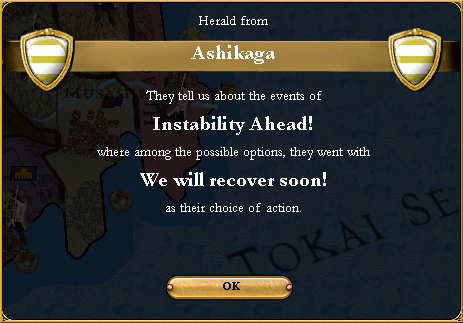
*
[1]Indeed, the post as commissioner of supply was one of the most important military positions of any Sengoku army.
[2]Term for a foot soldier, literally means ‘one who advances on foot’.
[3]As mentioned in the first chapter an “ikki” was a league of warriors or peasants in revolt.
Do you know your Sengoku films? Can you spot the cameos?
Last edited:



